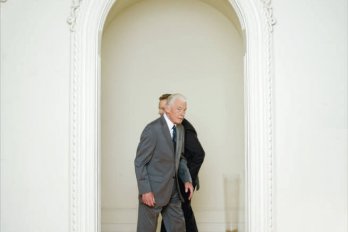A hundred and twenty years before Canada’s involvement in Afghanistan, a British prime minister identified the issue at the heart of current attempts to defeat the Taliban and reconstruct the country. In the midst of the “Great Game” between the British Empire and Tsarist Russia over influence in Central Asia, William Gladstone urged his fellow citizens to “remember that the sanctity of life in the hill villages of Afghanistan, among the winter snows, is as inviolable in the eye of Almighty God, as can be your own.”
Preserving the sanctity of life, however, is difficult when the enemy strikes unexpectedly, blends into the local populace, and enjoys growing support. Last October, for example, some twenty Afghan civilians were killed during two separate NATO attacks. First, a 2 a.m. helicopter strike on Taliban fighters destroyed several huts in the village of Ashogoh. The same day, a rocket accidentally struck a house during a firefight between NATO troops and the Taliban. President Hamid Karzai has summed up Afghanistan’s vulnerable position, stating, “We can’t prevent the terrorists from coming from Pakistan, and we can’t prevent the coalition from bombing the terrorists, and our children are dying because of this.”
Karzai’s comment encapsulates the challenge Canada now faces in Afghanistan. We must win local support for reconstruction efforts while also making war. These two tasks are not easily reconciled. As Afghan legislator Shukria Barakzai has warned, killing civilians will undermine NATO’s mission in Afghanistan (to say nothing of harsh treatment of detainees).
Although this poses a dilemma, it’s no reason to leave – a point on which a near consensus has emerged. While the Liberal Party supports moving forces out of Kandahar province (where the heaviest fighting is) in 2009, all national parties save the New Democrats agree that the humanitarian costs of withdrawing completely from the country outweigh the many challenges of staying. Indeed, successive Canadian governments have ultimately justified the mission in similar terms. Unlike Gladstone, we are trying to help the Afghans build a viable and independent state. With the official debate over Canada’s presence resolved for the time being, the question remains: how do we go about building peace while we’re still at war?
At the outset of our involvement in Afghanistan, shortly after 9/11, a senior official from a Canadian aid organization had a call put out to the Department of National Defence to find out if we were at war. With strict rules about neutrality in place, his agency wanted to determine what its involvement would be. An officer put the agency on hold, only to return and say that he’d have to get back to them.
In part, this confusion reflects the changing nature of international conflict. Canada’s long-held (and somewhat mythical) view of peacekeeping does not apply when the peace must be built before it can be kept. The use of a neutral blue helmet force to separate two warring armies simply doesn’t work in countries like Somalia, the Democratic Republic of the Congo, Sudan, Sierra Leone, and Afghanistan, where fighting over territory is often only one part of a loosely defined and highly complex struggle between organized crime rings, warlords, and, increasingly, insurgents. In such cases, poverty and instability lead to a vicious cycle of underdevelopment and violence. It takes more than soldiers to address the problem.
Recognizing this, Canada has shifted to a robust form of peace-building that brings defence into closer contact with diplomatic and development activities. Paul Martin introduced this approach first in speeches, then in his 2005 international policy statement, under the name “3D.” The Conservative government has since replaced this with the term “whole-of-government,” but the underlying philosophy remains the same. The Department of National Defence (DND), Foreign Affairs and International Trade Canada (DFAIT), and the Canadian International Development Agency (CIDA) must now work together to execute a common strategy.
Reconciling military, diplomatic, and humanitarian objectives may be a more effective way of stabilizing failed and fragile states, but it also creates inevitable trade-offs and requires a high degree of collaboration. 3D is simply easier on paper than it is in practice.
When diplomat Glyn Berry, whose job was to facilitate relationships between a wide range of Afghan groups, was killed by a suicide bomber in Kandahar on January 15, 2006, it was a striking blow to Canada’s strategy in Afghanistan. In many ways, Berry personified 3D. Working alongside development specialists and protected by the military, he was part of the effort to rebuild the country. Since Berry’s death, non-military personnel have largely been confined to secure bases in Kandahar. His replacement, Gavin Buchan, would like to “go out every day and talk to people on the street…but we’re not there yet and we’re not going to be there in the foreseeable future.” If Buchan and other diplomats are unable to do their jobs, and if development workers are similarly constrained, how can Canada claim to be implementing 3D?
This question is behind much of the criticism of our mission in Afghanistan. Analysts have noted that funding has been heavily weighted toward the military, at both the national and international levels. According to a 2006 report by the Senlis Council, the total defence expenditure for all parties in Afghanistan has outpaced development funding more than tenfold, and the ratio is similar for Canadian spending, although exact figures are hard to come by. On these grounds, it is difficult to dispute former foreign affairs minister Lloyd Axworthy’s claim that the mission “has become one big ‘D.’?”
Non-governmental organizations have also been vocal in their disapproval of military encroachment into the field of humanitarian assistance. For example, plainclothed US special forces have been known to use the kind of white trucks that are ubiquitous in the development community. There was also the US administration’s decision to drop food-ration packages roughly the same size and colour of unexploded cluster bombs from military planes. The confusion over the role of humanitarian workers that resulted from these and similar incidents severely jeopardized their security. On June 2, 2004, five Médecins Sans Frontières workers were killed in a clearly marked truck; a Taliban spokesperson stated that aid organizations thought to be working for American interests were legitimate targets. On July 28, after twenty-four years of active involvement in Afghanistan, MSF announced that it would be pulling out.
The issue of civilian protection is central to the 3D challenge. We may need to rethink a wide spectrum of tactics, from how we treat detainees to the nature of our military engagement. Air strikes, for example, can be an effective means of fighting the Taliban in hostile terrain with limited risk to our soldiers, but they also increase the likelihood that innocent civilians will be killed, turning local populations against Canadian troops.
The riots that have repeatedly broken out across the country protesting accidental deaths have borne this out. As Brigadier Richard Nugee, the chief spokesperson for the UN-authorized, NATO-led International Security Assistance Force (ISAF) has said, “The single thing that we have done wrong and we are striving extremely hard to improve on is killing innocent civilians.” Is this a fair appraisal of the costs, though? Put another way: if we knew terrorists were meeting at a home in Vancouver, Toronto, or Montreal, would we authorize air strikes? Within a 3D approach, the calculus for acceptable human casualties must be reevaluated.
John Watson, president of CARE Canada, a leading international relief and development organization, believes we’re not appropriately balancing military benefits against the wider costs. He places some of the blame on the military itself, which, he argues, is slowly co-opting development assistance under the rubric of defence. He points out that many of the concepts now associated with 3D peace-building – such as civil-military cooperation, provincial reconstruction teams, and “three-block war” – originated in military discourse, prescribe a lead role for the military, and value development and diplomacy only insofar as they are useful for the advancement of military objectives. It’s humanitarianism as a campaign for hearts and minds rather than as a moral responsibility.
It will not always be possible to simultaneously achieve all our goals, and some policies will inevitably contradict others. Indeed, Canadian involvement in Afghanistan has been many things to many people. What began as an exercise in national security and a response to global terrorism has gradually shifted toward humanitarian assistance and reconstruction. From a broader diplomatic perspective, it has also served to fulfill our commitment to NATO and provide an opportunity to repair relations with the United States, strained by our refusals to commit troops to the Iraq war and participate in ballistic missile defence. Serving multiple interests is justifiable, even desirable. The real problem is that while 3D calls for the integration of defence, diplomacy, and development, it does not lay out how they should be integrated.
The relationship between war and development in Afghanistan is something of a Catch-22. Many argue that you can’t build schools in a war zone. Others suggest that the suffering that persists in the absence of humanitarian assistance is increasing support for the Taliban, making the military fight more difficult. DND, in conjunction with the Prime Minister’s Office, has taken the lead on strategic decision-making in conflicts, which makes sense if security is viewed as a prerequisite for humanitarian action.
But the reality is that the three Ds are fundamentally interconnected, and the only way this tenuous balance can be managed is through collaboration – the cornerstone of 3D peace-building. If a particular military strategy has humanitarian implications, all relevant stakeholders need to be aware of them from the outset. This requires a level of public communication that doesn’t currently exist. DND, CIDA, and DFAIT have different mandates, operating procedures, and cultures, as well as different perspectives on Canada’s international policy and their respective roles. As an old adage about the UN reminds us, everybody is in favour of coordination, but no one likes to be coordinated.
The initial Canadian team in Kabul was acclaimed for their collaborative work. They benefited from their small size and the presence of an active ambassador; personal connections and joint experience in the field allowed them to overcome bureaucratic cultures. But with increased deployment to Kandahar, the advantage of scale was lost. As the Taliban grew in strength, new security restrictions emerged, and the military took the lead.
In Ottawa, the level of coordination between CIDA, DND, and DFAIT has seen some improvement. While the Prime Minister’s Office and DND continue to drive much of our Afghanistan policy, the three Ds are more sensitive to each other’s actions than ever before. However, more integration is necessary. Stephen Harper recently appointed an associate deputy minister within DFAIT to facilitate coordination, but it remains to be seen if the position, which lacks the authority exercised by the Prime Minister’s Office or the Privy Council Office, will have any real influence over the powerfully independent and resource-rich CIDA and DND.
The United Kingdom, an early adopter of 3D, has gone a step further by tying funding to collaboration. Instead of asking their development, defence, and diplomatic ministries to work together, Britain has made funding conditional on it through a joint-funding model called “conflict prevention pools.” Staffed by officials from across the bureaucracy, the pools bid alongside parent departments for resources. This brings policy analysts together permanently and establishes incentives for truly collaborative decision making. This may not be the right solution for Canada, but something similar may prove necessary if the departments continue to compete for influence and retain vestiges of their traditional roles.
Of course, if 3D rests on the assumption that only a comprehensive approach to the problems plaguing Afghanistan will be successful, then our partners must also coordinate. But we are operating as part of a thirty-seven-member coalition, ISAF, in which national contingents often have different mandates, priorities, and tactics. In September 2006, for example, the UK negotiated a deal in the Musa Qala district of Helmand province whereby tribal leaders would take control of the area if both Taliban and British forces withdrew. The United States viewed the compromise as a surrender, and when the Taliban overran Musa Qala in February 2007, ISAF, under US leadership, authorized air strikes rather than renegotiating the deal.
Debates over relative contributions and rules of engagement have also been fierce. The US, having initially secured the country with Operation Enduring Freedom, refocused most of its resources and troops to Iraq before it could contribute to the rebuilding process. Had the US stayed, Afghanistan would likely be more stable, and non-military personnel like Gavin Buchan would be in a better position to do their jobs.
We have a long way to go in Afghanistan. A recent Canadian Senate report pointed out that medieval societies change slowly, corruption is endemic, and the Taliban has the home-court advantage. Unfortunately, the Senate’s recommendations, which included additional military training, direct CIDA funding for military-led development projects, and the establishment of a corruption reduction strategy, simply do not match the scale of the problems they are meant to address.
If we are serious about staying, we need widespread public engagement. Behind facile debates about supporting the troops lie crucial questions. How exactly do we define success? What are our ultimate goals and objectives? What is our strategy for achieving them? Finding answers has been difficult partly because information has been so hard to come by. All public communication from the departments operating in Afghanistan (even from senior civil servants) must now be cleared by the Prime Minister’s Office.
In November 2006, the Conservative government spent a reported $76,000 on focus groups to evaluate its communications strategy on Afghanistan. The results suggested that justifying the mission as a response to terrorism and through appeals to freedom invoked, unfavourably, President Bush’s stance on the war in Iraq and that the preferred language would emphasize progress, development, and our commitment to reconstruction. This raises perhaps the most important question about Canadian involvement in Afghanistan: how do we explain our inability to live up to the political rhetoric surrounding 3D peace-building?
It may be that 3D is not what it seems, that the mission we’re being sold obscures less palatable objectives. The incentive to dress hard military objectives in soft humanitarian clothing has been present from the start, regardless of the party in charge. Protecting the country from future terrorist attacks is certainly as important as projecting humanitarian values, but there is no honour or integrity in mistaking one for the other.
It’s also possible that the strategy itself is flawed. Perhaps the civil service and ISAF are currently incapable of the type of collaboration 3D requires. And even if the political will is there, the resources may be lacking. Peace-building experiences in Africa and the Balkans suggest that the overall international contribution to Afghanistan remains substantially below the levels of military and economic support usually necessary to rebuild a state. Our talk of 3D peace-building may ultimately be too ambitious for the circumstances. However, this conclusion suggests an uncomfortable set of alternatives: either we aren’t truly committed to Afghanistan, or such nation-building projects are beyond our capacity.
But if the principles of 3D are sound, and the challenges are part and parcel of implementing a new approach, then actually putting the strategy into action should make a marked difference. In this case, 3D offers Canada a unique opportunity to once again demonstrate international leadership on issues of peace and security.
One conclusion is absolutely clear: lives, resources, and opportunities are at stake, and only after we have defined exactly what we intend to accomplish in Afghanistan will we be able to assess the prospects for success and justify the necessary sacrifices.






